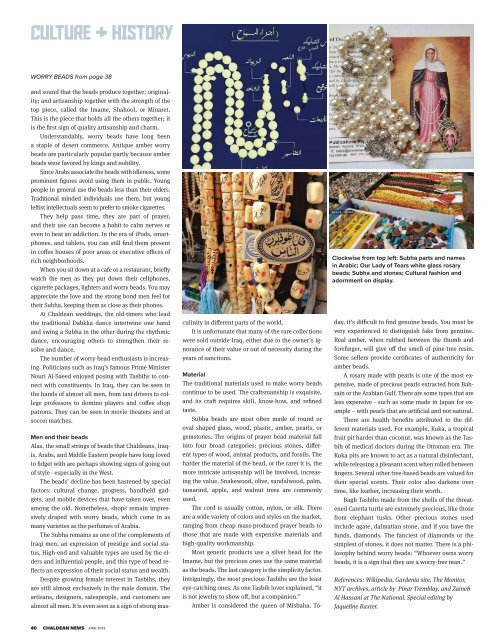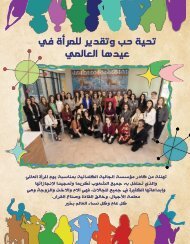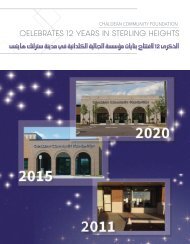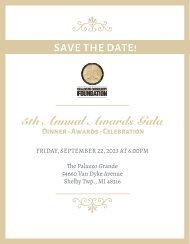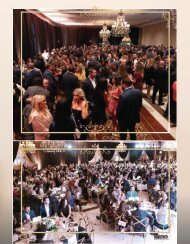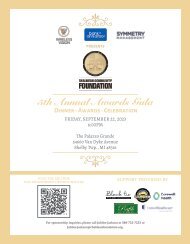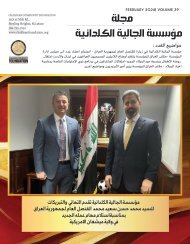Create successful ePaper yourself
Turn your PDF publications into a flip-book with our unique Google optimized e-Paper software.
CULTURE & HISTORY<br />
WORRY BEADS from page 38<br />
and sound that the beads produce together; originality;<br />
and artisanship together with the strength of the<br />
top piece, called the Imame, Shahool, or Minaret.<br />
This is the piece that holds all the others together; it<br />
is the first sign of quality artisanship and charm.<br />
Understandably, worry beads have long been<br />
a staple of desert commerce. Antique amber worry<br />
beads are particularly popular partly because amber<br />
beads were favored by kings and nobility.<br />
Since Arabs associate the beads with idleness, some<br />
prominent figures avoid using them in public. Young<br />
people in general use the beads less than their elders.<br />
Traditional minded individuals use them, but young<br />
leftist intellectuals seem to prefer to smoke cigarettes.<br />
They help pass time, they are part of prayer,<br />
and their use can become a habit to calm nerves or<br />
even to beat an addiction. In the era of iPods, smartphones,<br />
and tablets, you can still find them present<br />
in coffee houses of poor areas or executive offices of<br />
rich neighborhoods.<br />
When you sit down at a cafe or a restaurant, briefly<br />
watch the men as they put down their cellphones,<br />
cigarette packages, lighters and worry beads. You may<br />
appreciate the love and the strong bond men feel for<br />
their Subha, keeping them as close as their phones.<br />
At Chaldean weddings, the old-timers who lead<br />
the traditional Dabkka dance intertwine one hand<br />
and swing a Subha in the other during the rhythmic<br />
dance, encouraging others to strengthen their resolve<br />
and dance.<br />
The number of worry-bead enthusiasts is increasing.<br />
Politicians such as Iraq’s famous Prime Minister<br />
Nouri Al-Saeed enjoyed posing with Tasbihs to connect<br />
with constituents. In Iraq, they can be seen in<br />
the hands of almost all men, from taxi drivers to college<br />
professors to domino players and coffee shop<br />
patrons. They can be seen in movie theaters and at<br />
soccer matches.<br />
Men and their beads<br />
Alas, the small strings of beads that Chaldeans, Iraqis,<br />
Arabs, and Middle Eastern people have long loved<br />
to fidget with are perhaps showing signs of going out<br />
of style - especially in the West.<br />
The beads’ decline has been hastened by special<br />
factors: cultural change, progress, handheld gadgets,<br />
and mobile devices that have taken over, even<br />
among the old. Nonetheless, shops remain impressively<br />
draped with worry beads, which come in as<br />
many varieties as the perfumes of Arabia.<br />
The Subha remains as one of the complements of<br />
Iraqi men, an expression of prestige and social status.<br />
High-end and valuable types are used by the elders<br />
and influential people, and this type of bead reflects<br />
an expression of their social status and wealth.<br />
Despite growing female interest in Tasbihs, they<br />
are still almost exclusively in the male domain. The<br />
artisans, designers, salespeople, and customers are<br />
almost all men. It is even seen as a sign of strong masculinity<br />
in different parts of the world.<br />
It is unfortunate that many of the rare collections<br />
were sold outside Iraq, either due to the owner’s ignorance<br />
of their value or out of necessity during the<br />
years of sanctions.<br />
Clockwise from top left: Subha parts and names<br />
in Arabic; Our Lady of Tears white glass rosary<br />
beads; Subha and stones; Cultural fashion and<br />
adornment on display.<br />
Material<br />
The traditional materials used to make worry beads<br />
continue to be used. The craftsmanship is exquisite,<br />
and its craft requires skill, know-how, and refined<br />
taste.<br />
Subha beads are most often made of round or<br />
oval shaped glass, wood, plastic, amber, pearls, or<br />
gemstones. The origins of prayer bead material fall<br />
into four broad categories: precious stones, different<br />
types of wood, animal products, and fossils. The<br />
harder the material of the bead, or the rarer it is, the<br />
more intricate artisanship will be involved, increasing<br />
the value. Snakewood, olive, sandalwood, palm,<br />
tamarind, apple, and walnut trees are commonly<br />
used.<br />
The cord is usually cotton, nylon, or silk. There<br />
are a wide variety of colors and styles on the market,<br />
ranging from cheap mass-produced prayer beads to<br />
those that are made with expensive materials and<br />
high-quality workmanship.<br />
Most generic products use a silver bead for the<br />
Imame, but the precious ones use the same material<br />
as the beads. The last category is the simplicity factor.<br />
Intriguingly, the most precious Tasbihs are the least<br />
eye-catching ones. As one Tasbih lover explained, “it<br />
is not jewelry to show off, but a companion.”<br />
Amber is considered the queen of Misbaha. Today,<br />
it’s difficult to find genuine beads. You must be<br />
very experienced to distinguish fake from genuine.<br />
Real amber, when rubbed between the thumb and<br />
forefinger, will give off the smell of pine-tree resin.<br />
Some sellers provide certificates of authenticity for<br />
amber beads.<br />
A rosary made with pearls is one of the most expensive,<br />
made of precious pearls extracted from Bahrain<br />
or the Arabian Gulf. There are some types that are<br />
less expensive - such as some made in Japan for example<br />
– with pearls that are artificial and not natural.<br />
There are health benefits attributed to the different<br />
materials used. For example, Kuka, a tropical<br />
fruit pit harder than coconut, was known as the Tasbih<br />
of medical doctors during the Ottoman era. The<br />
Kuka pits are known to act as a natural disinfectant,<br />
while releasing a pleasant scent when rolled between<br />
fingers. Several other tree-based beads are valued for<br />
their special scents. Their color also darkens over<br />
time, like leather, increasing their worth.<br />
Bagh Tasbihs made from the shells of the threatened<br />
Caretta turtle are extremely precious, like those<br />
from elephant tusks. Other precious stones used<br />
include agate, dalmatian stone, and if you have the<br />
funds, diamonds. The fanciest of diamonds or the<br />
simplest of stones, it does not matter. There is a philosophy<br />
behind worry beads: “Whoever owns worry<br />
beads, it is a sign that they are a worry-free man.”<br />
References: Wikipedia, Gardenia site, The Monitor,<br />
NYT archives, article by Pinar Tremblay, and Zaineb<br />
Al Hassani at The National. Special editing by<br />
Jaqueline Raxter.<br />
40 CHALDEAN NEWS <strong>JUNE</strong> <strong>2022</strong>


